FIN 1040 Microeconomics Assignment: Video Game Console Market Trends
VerifiedAdded on 2023/06/10
|10
|1505
|384
Homework Assignment
AI Summary
This microeconomics assignment analyzes the video game console market, identifying it as an oligopoly dominated by a few large brands. It examines sales trends from 2008 to 2015, noting an overall decrease in console sales alongside shifts in brand popularity and the rise of smartphone and tablet gaming. The increasing demand for mobile games is shown to negatively impact the console market by reducing demand. The assignment also discusses price stability due to product differentiation and relatively inelastic consumer demand. Finally, it argues against the formation of cartels in this market, suggesting that a lack of competition would stifle product improvement and further decrease demand, especially given the competition from mobile gaming. Desklib offers a wide array of resources, including past papers and solved assignments, for students seeking assistance with their studies.

Running head: MICROECONOMICS ASSIGNMENT
Microeconomics Assignment
Name of the Student
Name of the University
Author Note
Microeconomics Assignment
Name of the Student
Name of the University
Author Note
Paraphrase This Document
Need a fresh take? Get an instant paraphrase of this document with our AI Paraphraser
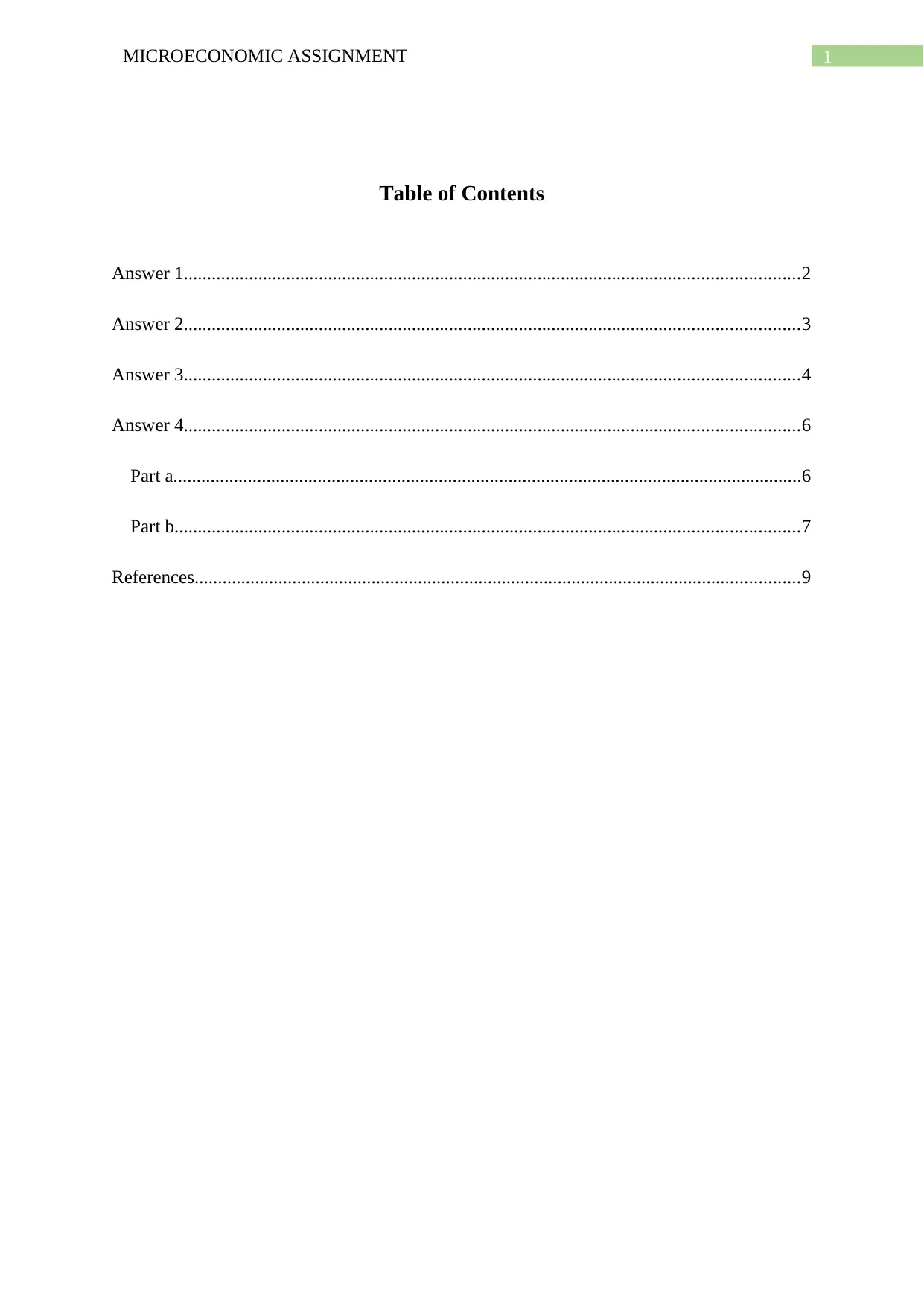
1MICROECONOMIC ASSIGNMENT
Table of Contents
Answer 1....................................................................................................................................2
Answer 2....................................................................................................................................3
Answer 3....................................................................................................................................4
Answer 4....................................................................................................................................6
Part a.......................................................................................................................................6
Part b......................................................................................................................................7
References..................................................................................................................................9
Table of Contents
Answer 1....................................................................................................................................2
Answer 2....................................................................................................................................3
Answer 3....................................................................................................................................4
Answer 4....................................................................................................................................6
Part a.......................................................................................................................................6
Part b......................................................................................................................................7
References..................................................................................................................................9

2MICROECONOMIC ASSIGNMENT
Answer 1
The video game consoles market, as can be seen from the following figure, can be
seen to be dominated by several large brands, shown as follows:
Figure 1: Video Game Consoles Market
(Source: As retrieved from question file)
The concerned market, being over the years, dominated by a small number of large
brands can be categorised as an oligopolistic market, in the conceptual framework of
economics. An oligopolistic market, in general framework, is characterised by few big sellers
and many buyers, with each of the few sellers enjoying considerable share of the market as
well as clientele, thereby earning considerable share of revenue and profit (Fudenberg and
Tirole 2013). The supply side providers in this type of market structure enjoys market power
to some extent and each of their products differ from one another, in some attributes, at least
in the brand name.
There are mainly two types of oligopolistic market, one where there occurs price war
among the competing firms and the other in which the sellers compete with one another on
the basis of differences in the quality and attributes of their products (Frank and Cartwright
2013). The market of video game consoles appears to be more of the second type than the
first type of oligopolistic market.
Answer 1
The video game consoles market, as can be seen from the following figure, can be
seen to be dominated by several large brands, shown as follows:
Figure 1: Video Game Consoles Market
(Source: As retrieved from question file)
The concerned market, being over the years, dominated by a small number of large
brands can be categorised as an oligopolistic market, in the conceptual framework of
economics. An oligopolistic market, in general framework, is characterised by few big sellers
and many buyers, with each of the few sellers enjoying considerable share of the market as
well as clientele, thereby earning considerable share of revenue and profit (Fudenberg and
Tirole 2013). The supply side providers in this type of market structure enjoys market power
to some extent and each of their products differ from one another, in some attributes, at least
in the brand name.
There are mainly two types of oligopolistic market, one where there occurs price war
among the competing firms and the other in which the sellers compete with one another on
the basis of differences in the quality and attributes of their products (Frank and Cartwright
2013). The market of video game consoles appears to be more of the second type than the
first type of oligopolistic market.
⊘ This is a preview!⊘
Do you want full access?
Subscribe today to unlock all pages.

Trusted by 1+ million students worldwide
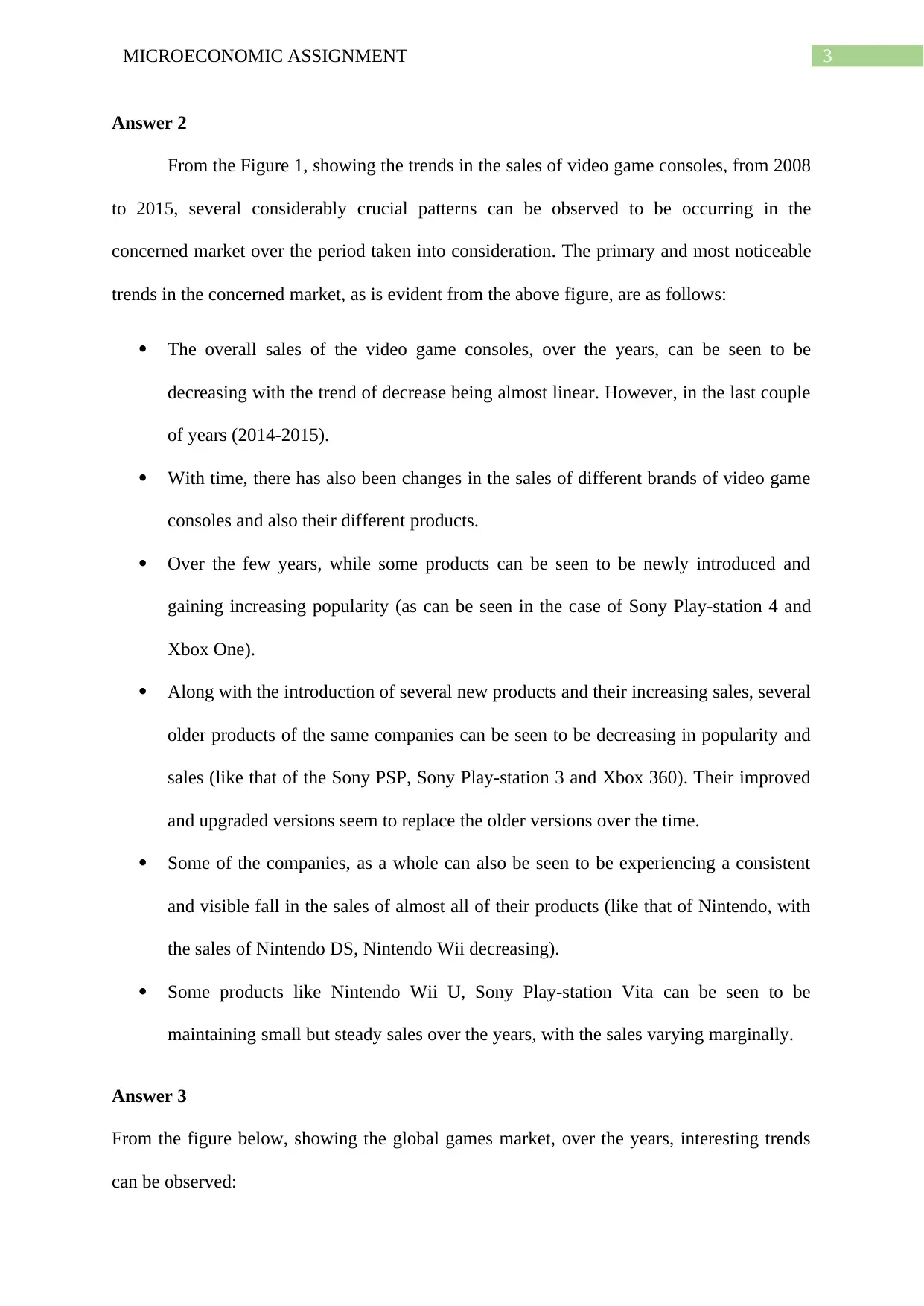
3MICROECONOMIC ASSIGNMENT
Answer 2
From the Figure 1, showing the trends in the sales of video game consoles, from 2008
to 2015, several considerably crucial patterns can be observed to be occurring in the
concerned market over the period taken into consideration. The primary and most noticeable
trends in the concerned market, as is evident from the above figure, are as follows:
The overall sales of the video game consoles, over the years, can be seen to be
decreasing with the trend of decrease being almost linear. However, in the last couple
of years (2014-2015).
With time, there has also been changes in the sales of different brands of video game
consoles and also their different products.
Over the few years, while some products can be seen to be newly introduced and
gaining increasing popularity (as can be seen in the case of Sony Play-station 4 and
Xbox One).
Along with the introduction of several new products and their increasing sales, several
older products of the same companies can be seen to be decreasing in popularity and
sales (like that of the Sony PSP, Sony Play-station 3 and Xbox 360). Their improved
and upgraded versions seem to replace the older versions over the time.
Some of the companies, as a whole can also be seen to be experiencing a consistent
and visible fall in the sales of almost all of their products (like that of Nintendo, with
the sales of Nintendo DS, Nintendo Wii decreasing).
Some products like Nintendo Wii U, Sony Play-station Vita can be seen to be
maintaining small but steady sales over the years, with the sales varying marginally.
Answer 3
From the figure below, showing the global games market, over the years, interesting trends
can be observed:
Answer 2
From the Figure 1, showing the trends in the sales of video game consoles, from 2008
to 2015, several considerably crucial patterns can be observed to be occurring in the
concerned market over the period taken into consideration. The primary and most noticeable
trends in the concerned market, as is evident from the above figure, are as follows:
The overall sales of the video game consoles, over the years, can be seen to be
decreasing with the trend of decrease being almost linear. However, in the last couple
of years (2014-2015).
With time, there has also been changes in the sales of different brands of video game
consoles and also their different products.
Over the few years, while some products can be seen to be newly introduced and
gaining increasing popularity (as can be seen in the case of Sony Play-station 4 and
Xbox One).
Along with the introduction of several new products and their increasing sales, several
older products of the same companies can be seen to be decreasing in popularity and
sales (like that of the Sony PSP, Sony Play-station 3 and Xbox 360). Their improved
and upgraded versions seem to replace the older versions over the time.
Some of the companies, as a whole can also be seen to be experiencing a consistent
and visible fall in the sales of almost all of their products (like that of Nintendo, with
the sales of Nintendo DS, Nintendo Wii decreasing).
Some products like Nintendo Wii U, Sony Play-station Vita can be seen to be
maintaining small but steady sales over the years, with the sales varying marginally.
Answer 3
From the figure below, showing the global games market, over the years, interesting trends
can be observed:
Paraphrase This Document
Need a fresh take? Get an instant paraphrase of this document with our AI Paraphraser
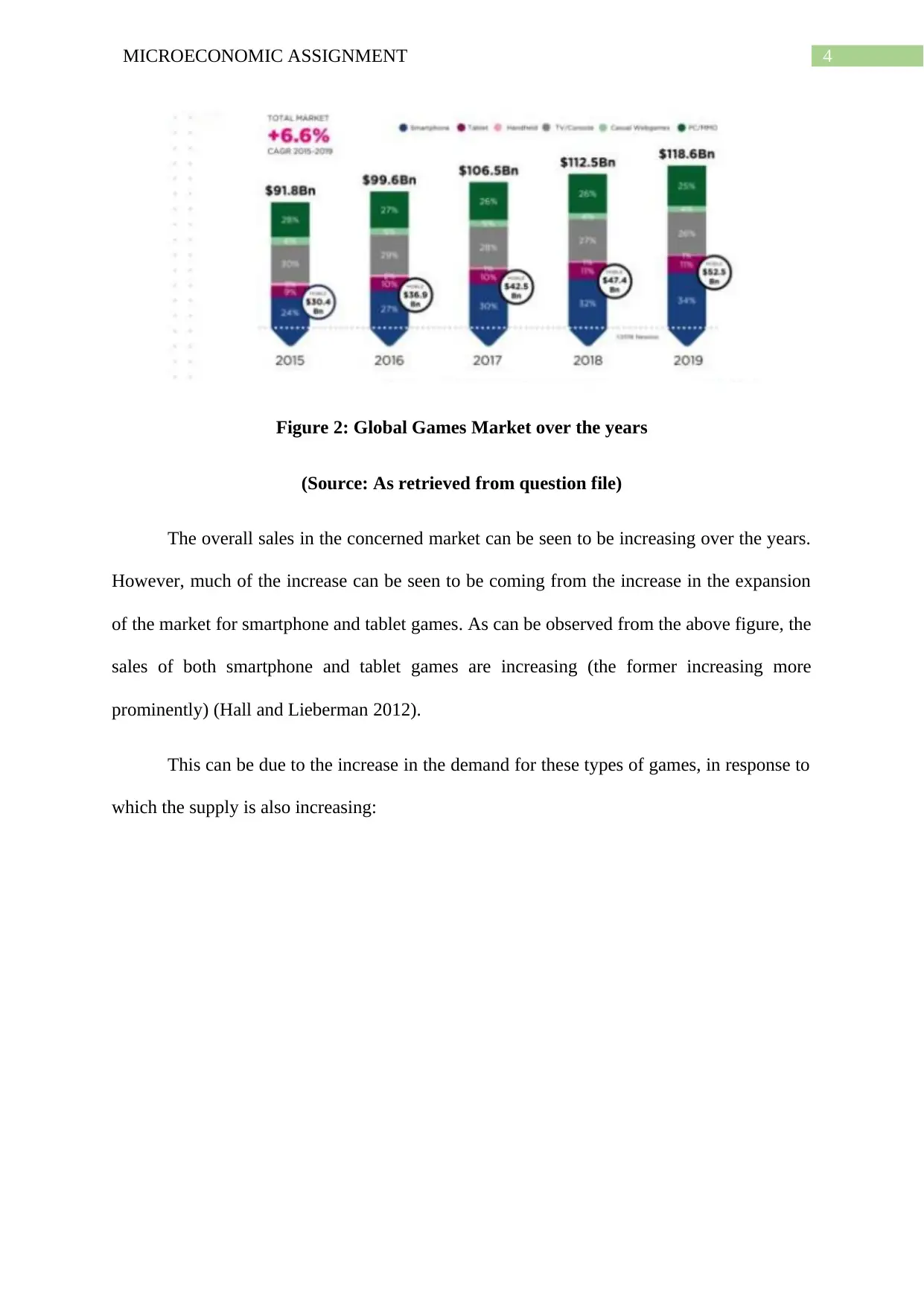
4MICROECONOMIC ASSIGNMENT
Figure 2: Global Games Market over the years
(Source: As retrieved from question file)
The overall sales in the concerned market can be seen to be increasing over the years.
However, much of the increase can be seen to be coming from the increase in the expansion
of the market for smartphone and tablet games. As can be observed from the above figure, the
sales of both smartphone and tablet games are increasing (the former increasing more
prominently) (Hall and Lieberman 2012).
This can be due to the increase in the demand for these types of games, in response to
which the supply is also increasing:
Figure 2: Global Games Market over the years
(Source: As retrieved from question file)
The overall sales in the concerned market can be seen to be increasing over the years.
However, much of the increase can be seen to be coming from the increase in the expansion
of the market for smartphone and tablet games. As can be observed from the above figure, the
sales of both smartphone and tablet games are increasing (the former increasing more
prominently) (Hall and Lieberman 2012).
This can be due to the increase in the demand for these types of games, in response to
which the supply is also increasing:
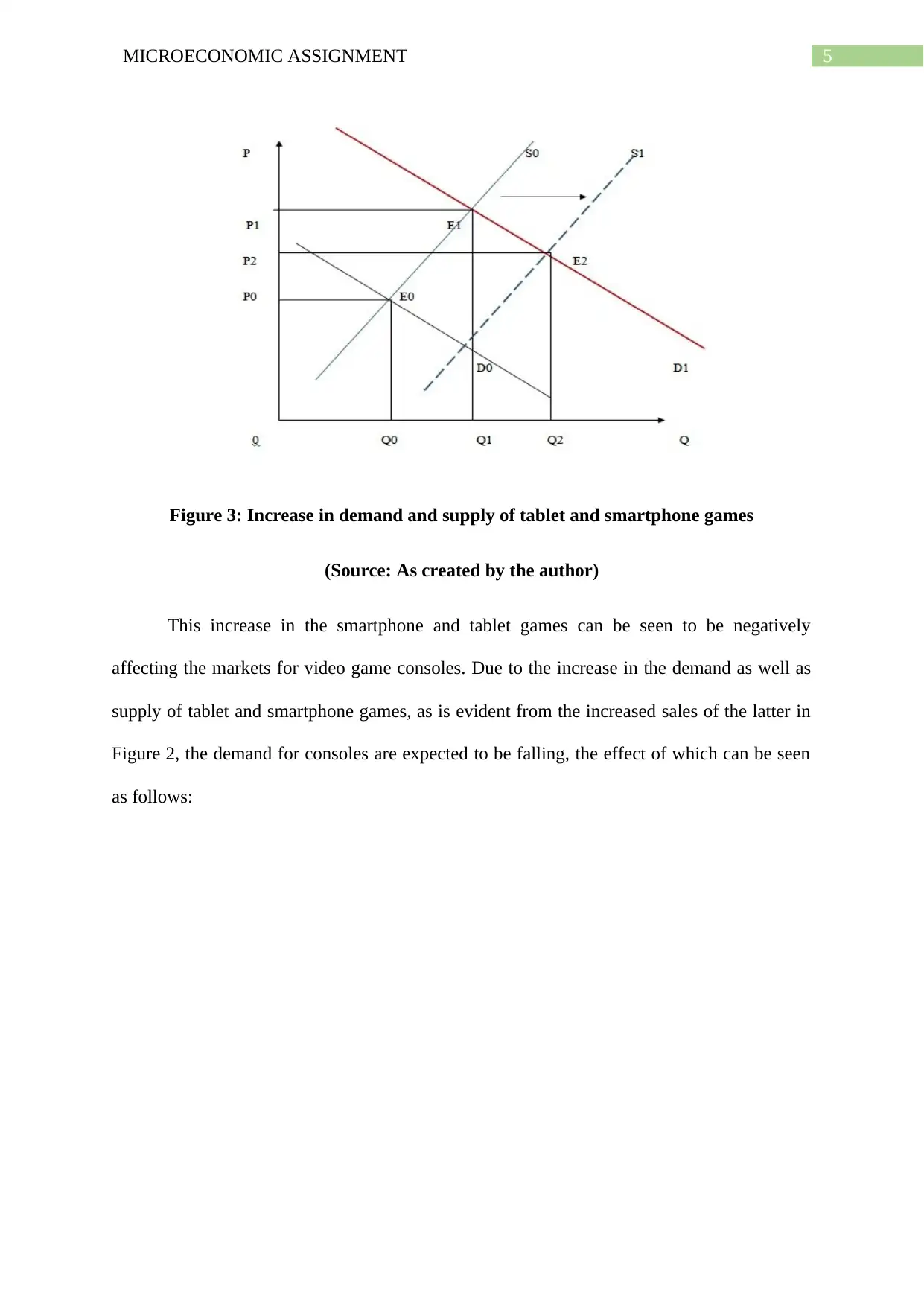
5MICROECONOMIC ASSIGNMENT
Figure 3: Increase in demand and supply of tablet and smartphone games
(Source: As created by the author)
This increase in the smartphone and tablet games can be seen to be negatively
affecting the markets for video game consoles. Due to the increase in the demand as well as
supply of tablet and smartphone games, as is evident from the increased sales of the latter in
Figure 2, the demand for consoles are expected to be falling, the effect of which can be seen
as follows:
Figure 3: Increase in demand and supply of tablet and smartphone games
(Source: As created by the author)
This increase in the smartphone and tablet games can be seen to be negatively
affecting the markets for video game consoles. Due to the increase in the demand as well as
supply of tablet and smartphone games, as is evident from the increased sales of the latter in
Figure 2, the demand for consoles are expected to be falling, the effect of which can be seen
as follows:
⊘ This is a preview!⊘
Do you want full access?
Subscribe today to unlock all pages.

Trusted by 1+ million students worldwide

6MICROECONOMIC ASSIGNMENT
Figure 4: Impact of increase in sales of smartphone games on video game console
market
(Source: As created by the author)
Due to the increase in sales of smartphone games, there is a fall in demand for video
game console, which in turn has the probability of a fall in the supply of the same in the long
run (Rader 2014).
Answer 4
Part a
In the above discussed markets, there exist stability of prices and also less tendency of
price wars as there are several companies and each of them differentiate their products on the
basis of qualities and features and therefore, each of them has loyal clientele who tend to
choose the products as per their preference and requirements, which in turn decreases the
Figure 4: Impact of increase in sales of smartphone games on video game console
market
(Source: As created by the author)
Due to the increase in sales of smartphone games, there is a fall in demand for video
game console, which in turn has the probability of a fall in the supply of the same in the long
run (Rader 2014).
Answer 4
Part a
In the above discussed markets, there exist stability of prices and also less tendency of
price wars as there are several companies and each of them differentiate their products on the
basis of qualities and features and therefore, each of them has loyal clientele who tend to
choose the products as per their preference and requirements, which in turn decreases the
Paraphrase This Document
Need a fresh take? Get an instant paraphrase of this document with our AI Paraphraser
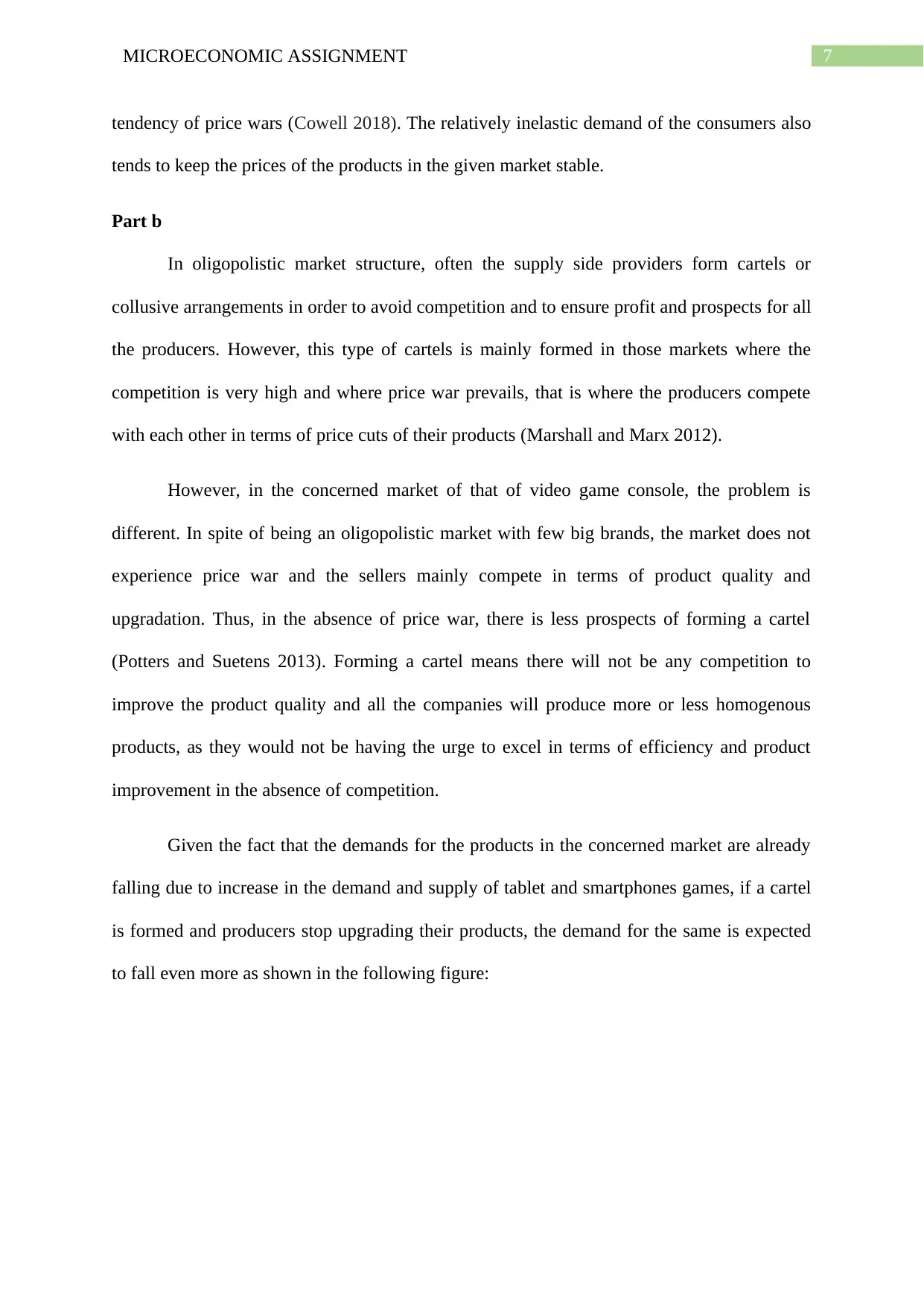
7MICROECONOMIC ASSIGNMENT
tendency of price wars (Cowell 2018). The relatively inelastic demand of the consumers also
tends to keep the prices of the products in the given market stable.
Part b
In oligopolistic market structure, often the supply side providers form cartels or
collusive arrangements in order to avoid competition and to ensure profit and prospects for all
the producers. However, this type of cartels is mainly formed in those markets where the
competition is very high and where price war prevails, that is where the producers compete
with each other in terms of price cuts of their products (Marshall and Marx 2012).
However, in the concerned market of that of video game console, the problem is
different. In spite of being an oligopolistic market with few big brands, the market does not
experience price war and the sellers mainly compete in terms of product quality and
upgradation. Thus, in the absence of price war, there is less prospects of forming a cartel
(Potters and Suetens 2013). Forming a cartel means there will not be any competition to
improve the product quality and all the companies will produce more or less homogenous
products, as they would not be having the urge to excel in terms of efficiency and product
improvement in the absence of competition.
Given the fact that the demands for the products in the concerned market are already
falling due to increase in the demand and supply of tablet and smartphones games, if a cartel
is formed and producers stop upgrading their products, the demand for the same is expected
to fall even more as shown in the following figure:
tendency of price wars (Cowell 2018). The relatively inelastic demand of the consumers also
tends to keep the prices of the products in the given market stable.
Part b
In oligopolistic market structure, often the supply side providers form cartels or
collusive arrangements in order to avoid competition and to ensure profit and prospects for all
the producers. However, this type of cartels is mainly formed in those markets where the
competition is very high and where price war prevails, that is where the producers compete
with each other in terms of price cuts of their products (Marshall and Marx 2012).
However, in the concerned market of that of video game console, the problem is
different. In spite of being an oligopolistic market with few big brands, the market does not
experience price war and the sellers mainly compete in terms of product quality and
upgradation. Thus, in the absence of price war, there is less prospects of forming a cartel
(Potters and Suetens 2013). Forming a cartel means there will not be any competition to
improve the product quality and all the companies will produce more or less homogenous
products, as they would not be having the urge to excel in terms of efficiency and product
improvement in the absence of competition.
Given the fact that the demands for the products in the concerned market are already
falling due to increase in the demand and supply of tablet and smartphones games, if a cartel
is formed and producers stop upgrading their products, the demand for the same is expected
to fall even more as shown in the following figure:
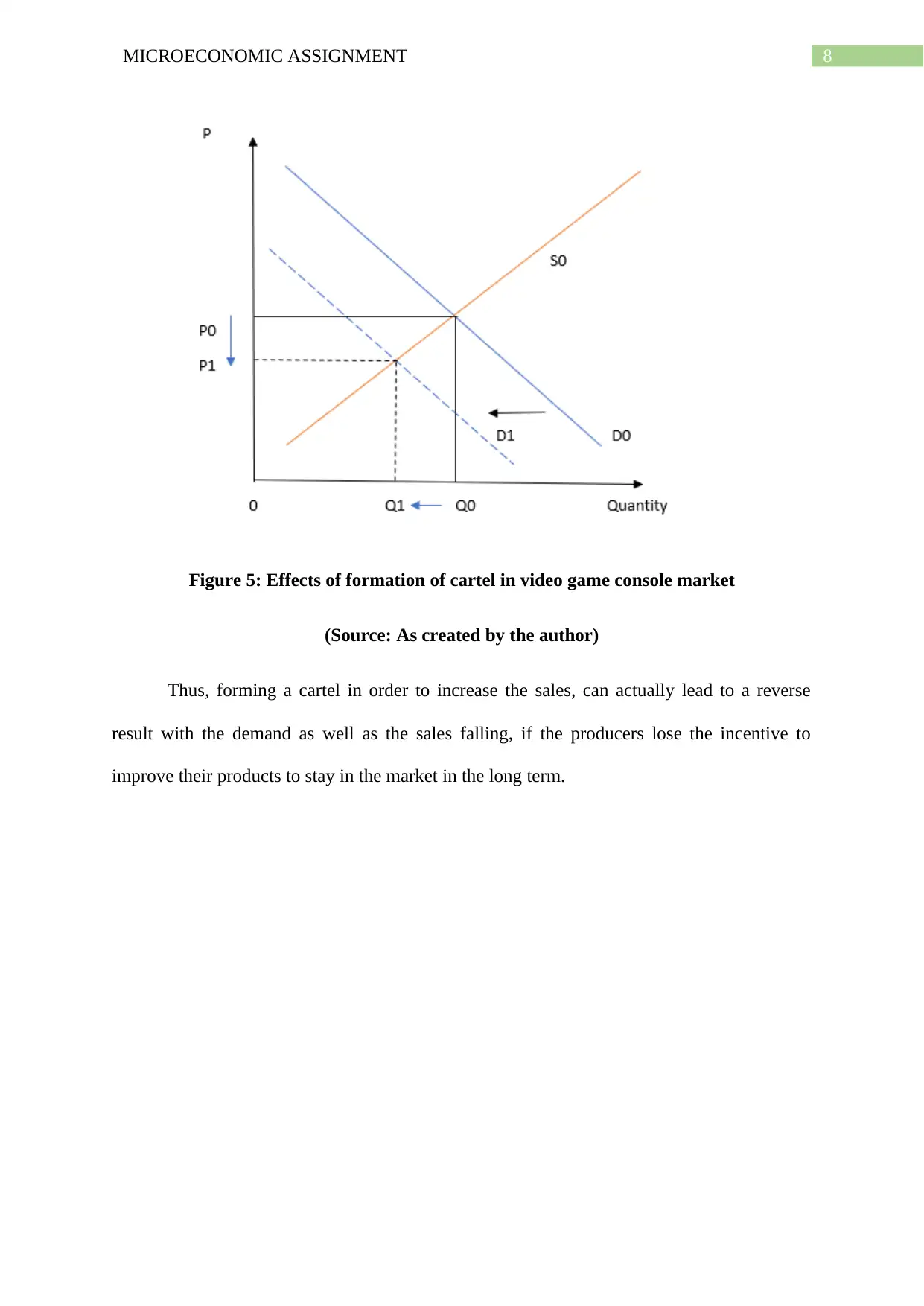
8MICROECONOMIC ASSIGNMENT
Figure 5: Effects of formation of cartel in video game console market
(Source: As created by the author)
Thus, forming a cartel in order to increase the sales, can actually lead to a reverse
result with the demand as well as the sales falling, if the producers lose the incentive to
improve their products to stay in the market in the long term.
Figure 5: Effects of formation of cartel in video game console market
(Source: As created by the author)
Thus, forming a cartel in order to increase the sales, can actually lead to a reverse
result with the demand as well as the sales falling, if the producers lose the incentive to
improve their products to stay in the market in the long term.
⊘ This is a preview!⊘
Do you want full access?
Subscribe today to unlock all pages.

Trusted by 1+ million students worldwide
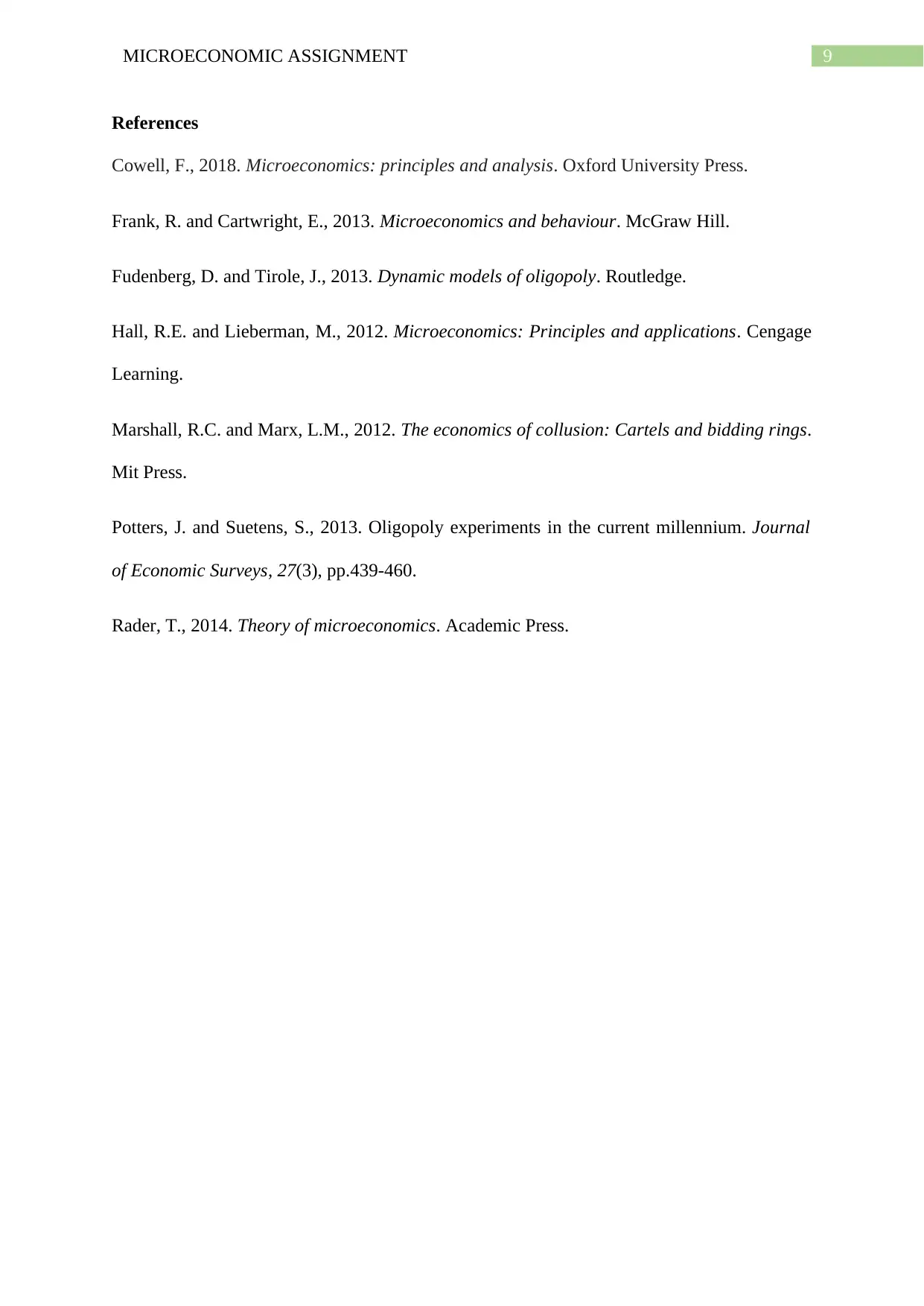
9MICROECONOMIC ASSIGNMENT
References
Cowell, F., 2018. Microeconomics: principles and analysis. Oxford University Press.
Frank, R. and Cartwright, E., 2013. Microeconomics and behaviour. McGraw Hill.
Fudenberg, D. and Tirole, J., 2013. Dynamic models of oligopoly. Routledge.
Hall, R.E. and Lieberman, M., 2012. Microeconomics: Principles and applications. Cengage
Learning.
Marshall, R.C. and Marx, L.M., 2012. The economics of collusion: Cartels and bidding rings.
Mit Press.
Potters, J. and Suetens, S., 2013. Oligopoly experiments in the current millennium. Journal
of Economic Surveys, 27(3), pp.439-460.
Rader, T., 2014. Theory of microeconomics. Academic Press.
References
Cowell, F., 2018. Microeconomics: principles and analysis. Oxford University Press.
Frank, R. and Cartwright, E., 2013. Microeconomics and behaviour. McGraw Hill.
Fudenberg, D. and Tirole, J., 2013. Dynamic models of oligopoly. Routledge.
Hall, R.E. and Lieberman, M., 2012. Microeconomics: Principles and applications. Cengage
Learning.
Marshall, R.C. and Marx, L.M., 2012. The economics of collusion: Cartels and bidding rings.
Mit Press.
Potters, J. and Suetens, S., 2013. Oligopoly experiments in the current millennium. Journal
of Economic Surveys, 27(3), pp.439-460.
Rader, T., 2014. Theory of microeconomics. Academic Press.
1 out of 10
Related Documents
Your All-in-One AI-Powered Toolkit for Academic Success.
+13062052269
info@desklib.com
Available 24*7 on WhatsApp / Email
![[object Object]](/_next/static/media/star-bottom.7253800d.svg)
Unlock your academic potential
Copyright © 2020–2025 A2Z Services. All Rights Reserved. Developed and managed by ZUCOL.





